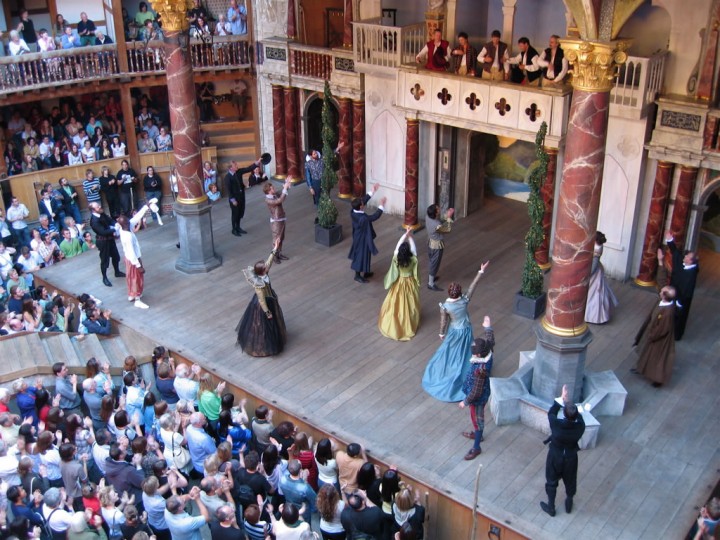
All the world’s a stage
And all the men and women merely players;
They have their exits and entrances,
And one man in his time plays many parts…
(Shakespeare, 1623, As You Like It, Act 2, Scene 7)
Introduction
The above well-known and oft-used quote from Shakepeare’s As You Like It is perhaps a fitting way to describe Goffman’s (1959) seminal work on the notion of “self-concept” through the conceit of the theatre, or “dramaturgical perspectives” as Goffman prefers to call it. Goffman’s work is situated within the broad symbolic interactionism (Cooley, 1912; Mead, 1934; Blumer, 1969; Manis & Meltzer, 1972) traditions. The question for me is whether this tradition is an appropriate lens to examine the professional learning of academic in Higher Education. Furthermore, does this tradition align itself comfortably with that of sociomaterialism? If so, how?
Symbolic interactionism (SI) caught my interest and imagination way back in 1995 as I was embarking on my first degree, a BSc in Information Technology and Social Science. Reading the essay that I wrote at that time, I am wincing at my unsophisticated attempts to construct an argument. More recently, I also attempted, rather clumsily I might add, to explain to someone what I thought SI was all about. After a 20 year hiatus, I think it is about time I reacquaint myself with an “old friend”.
Symbolic Interactionism
Symbolic interactionism is a sociological perspective that is concerned with the concept that individuals are continually being defined and redefined by those things (symbolic representations) that have meaning for them. SI involves three basic precepts:
- The individual responds to their environment based upon the “meanings” that these “things” have for them;
- Such “meanings” are derived from their social interaction with and about these “things”;
- These “meanings” become modified through the individual’s interpretation of the “things” within the sphere of the social interaction.
From the perspective of objects and tools, it is interesting to note what Claxton & Murray (1994) have to say about it:
…symbolic interaction with material and non-material culture enables the individual to develop a sense of self, become socialized, participate in society, and understand the roles and significance of other people. (ibid., para.2)
Furthermore, these symbolic representations can take on many dimensions, such as language, gestures, non-verbal communication, clothes, hair styles, colour of clothes, fashion accessories, the nuances and tones of the voice, gender, occupation, race, etc. All these symbolic representations are open to personal interpretation and will depend upon how we interpret, or unlock, these “symbolic codes” to determine a particular action or course of events.
In my 1995 essay, I used the following illustration to describe what I mean by SI. It concerns a man and woman in a dark, empty room sitting at a table. On the table is a solitary candle, the man lights the candle. To the casual observer, this act could symbolise many things:
- the room has no gas or electricity, so the candle provides a source of light and warmth;
- the candle was lit as a prelude to an evening of intimacy;
- there may be a religious significance attached to it; or
- perhaps they are celebrating a birthday, or anniversary, or some other special occasion.
In each case, a different interpretation has been bestowed on the very act of lighting a candle. To understand the what this “act” actually means will require the observer to uncover what the “act” meant to the actors involved.
The Dramaturgical Perspective
Applying Goffman’s (1959) “dramaturgical perspective”, we have the following components:
- The Room – This is the front It is the “setting” that involves furniture, decor, physical layout and other miscellaneous background items which provide the “scenery” and “stage props” in which the actors and the action will draw upon (ibid., p.32).
- The Man and the Woman – They are the “performers” or performance team. They are the “set of individuals who cooperate in staging a single routine”, which we could call an “act” (, p.85).
- The Casual Observer – They are the audience. They are watching the events and interactions unfold.
- The Empty Room – The room is bare, apart from a couple of chairs, a table and a candle. This could be construed as frugal living or the couple may be poor. This could be an example of idealization whereby the “performers” wish to present to the audience an “idealized view” of frugal living or, perhaps, poverty (, p.44).
- Lighting the Candle – At this point, the act of lighting the candle could be construed as an example of mystification (, p.74) because it is unclear what is happening and the audience, out of respect to the “performers” may feel a sense of “awe and distance” regarding the event taking place.
What happens if the “performers” held hands and started to pray? This very “act” now becomes a dramatic realization (ibid., p.40) as the “performers” have now “dramatically hightlight[ed] and portray[ed] confirmatory facts” to the audience which may have remained “unapparent or obscure” to them at the time.
What if the “performers” left the room by the door at the back, leaving the audience behind? The “performers” can now relax and let slip their “masks” as they take to the backstage (ibid., p.114) away from any scrutiny by the audience. It is here that the carefully crafted illusions, impressions and fictions used for the purposes of the performance and the audience known as impression management (ibid., p.116) are discarded.
There are individuals who are neither “performers” nor the audience known as outsiders (ibid., p.135) who could potentially mislead or disrupt a performance.
Object-Subject Interchangeability
Quite fortuitously, I have come across a brief paper by Claxton & Murray (1994) on the concept of interchangeability, they suggest that:
… [it] refer[s] to a psycho-social mechanism that permits individuals to selectively substitute the influences of objects and subjects (other people) for each other as necessary to construct, adapt, and maintain self definition (ibid., para.3)
From an SI perspective, materialism is neither positive nor negative. Indeed, the individual defines and redefines themselves through their interaction with objects (ibid., para.9). It could be argued that identities of self could “reside” in objects more so than in individuals (McCarthy, 1984); thus the “objects come to symbolize the self and thereby become part of self concept” (Claxton & Murray, 1994, para.12). Claxton & Murray (1994) introduce their model of interchangeability which attempts to align concepts of SI with materialism:
[The model] represents the relationship among subjects, objects, and self-definition. The model suggests that, in some cases, when someone cannot adequately integrate aspects of other people into his or her self-definition, then objects may be substituted, consciously or otherwise. In other words, the respective contributions of subjects and objects to the individual’s continuing development may be substitutable for each other at various times (ibid., para.18).
Furthermore, they go on to suggest that:
… objects and subjects do not simply make “non-human” and “human” contributions, respectively, to self-definition. Although the model represents a social/material duality, each may contain part of the other, and serve in the other’s role at certain times. Such is the case when people are used as objects (objectification), and when objects are viewed as possessing human qualities (anthropomorphism). In other words, the lines of contribution between object and subject to self-definition may sometimes blur (ibid., para.21).
Conclusion
There is just the first step in attempting to look at professional learning of academic in Higher Education through the objects that they use and the spaces that they occupied. Equally, it is important to understand about those objects and spaces that they choose to reject.
References
Blumer, H. (1969). Symbolic Interactionism: Perspective and Method. Berkeley, CA: University of California Press.
Claxton, R.P. & Murray, J.B. (1994). “Object-Subject Interchangeability: a Symbolic Interactionist Model of Materialism”. In: Allen, C.T. & John, D.R. (Eds.). NA – Advances in Consumer Research, 21. Provo, UT: Association for Consumer Research. pp. 422-426. Available at: http://acrwebsite.org/volumes/7628/volumes/v21/NA-21 [Accessed 21.11.2015].
Cooley, C.H., (1912). Human Nature and the Social Order. New York, NY: Scribners.
Csikszentmihalyi, M. (1993). “Why We Need Things”. In: Lubar, S. & Kingery, W.D. (Eds.). History from Things: Essays on Material Culture. Washington, DC: Smithsonian Institution Press. pp. 20-29.
Csikszentmihalyi, M. (2000). “The Costs and Benefits of Consuming”. Journal of Consumer Research, 27(2), pp. 267-272. Available at: http://www.jstor.org/stable/10.1086/314324 [Accessed 22.11.2015].
Csikszentmihalyi, M. & Rochberg-Halton, E. (1981). The Meaning of Things: Domestic Symbols and the Self. New York, NY: Cambridge University Press.
Donne, J. (2007, [1624]). Devotions Upon Emergent Occasions. Project Gutenberg Literary Archive Foundation. Available at: http://www.gutenberg.org/ebooks/23772 [Accessed 22.11.2015].
Goffman, E. (1959). The Presentation of Self in Everyday Life. London, England: Penguin Books.
Manis, J.G. & Meltzer, B.N. (Eds.). (1972). Symbolic Interaction: A Reader in Social Psychology. 2nd Edition. Boston, MA: Allyn & Bacon.
McCarthy, E.D. (1984). “Toward a Sociology of the Physical World: George Herbert Mead on Physical Objects”. In: Denzen, N.K. (Ed.). Studies in Symbolic Interaction. Greenwich, CT: JAI Press. pp. 105-121.
Mead, G.H. (1934). Mind, Self and Society. Chicago, IL: University of Chicago Press.
Shakespeare, W. (1992, [1623]). As You Like It. Hertfordshire, England: Wordsworth Classics.
Solomon, M.R.(1983). “The Role of Products as Social Stimuli: A Symbolic Interactionist Perspective”. Journal of Consumer Research, 10(3), pp. 319-329. Available at: http://www.jstor.org/stable/2488804 [Accessed 22.11.2015].
